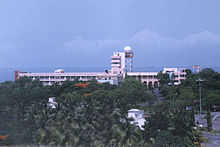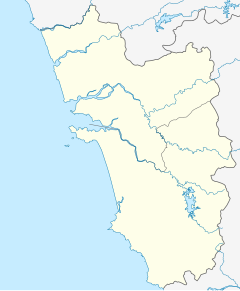
Oceanography, also known as oceanology, sea science and ocean science, is the scientific study of the oceans. It is an Earth science, which covers a wide range of topics, including ecosystem dynamics; ocean currents, waves, and geophysical fluid dynamics; plate tectonics and seabed geology; and fluxes of various chemical substances and physical properties within the ocean and across its boundaries. These diverse topics reflect multiple disciplines that oceanographers utilize to glean further knowledge of the world ocean, including astronomy, biology, chemistry, climatology, geography, geology, hydrology, meteorology and physics. Paleoceanography studies the history of the oceans in the geologic past. An oceanographer is a person who studies many matters concerned with oceans, including marine geology, physics, chemistry, and biology.
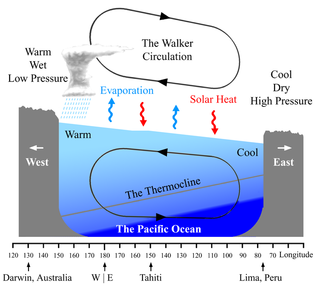
The Walker circulation, also known as the Walker cell, is a conceptual model of the air flow in the tropics in the lower atmosphere (troposphere). According to this model, parcels of air follow a closed circulation in the zonal and vertical directions. This circulation, which is roughly consistent with observations, is caused by differences in heat distribution between ocean and land. It was discovered by Gilbert Walker. In addition to motions in the zonal and vertical direction the tropical atmosphere also has considerable motion in the meridional direction as part of, for example, the Hadley Circulation.

The Equatorial Counter Current is an eastward flowing, wind-driven current which extends to depths of 100–150 metres (330–490 ft) in the Atlantic, Indian, and Pacific Oceans. More often called the North Equatorial Countercurrent (NECC), this current flows west-to-east at about 3-10°N in the Atlantic, Indian Ocean and Pacific basins, between the North Equatorial Current (NEC) and the South Equatorial Current (SEC). The NECC is not to be confused with the Equatorial Undercurrent (EUC) that flows eastward along the equator at depths around 200 metres (660 ft) in the western Pacific rising to 100 metres (330 ft) in the eastern Pacific.

The Indian Monsoon Current refers to the seasonally varying ocean current regime found in the tropical regions of the northern Indian Ocean. During winter, the flow of the upper ocean is directed westward from near the Indonesian Archipelago to the Arabian Sea. During the summer, the direction reverses, with eastward flow extending from Somalia into the Bay of Bengal. These variations are due to changes in the wind stress associated with the Indian monsoon. The seasonally reversing open ocean currents that pass south of India are referred to as the Winter Monsoon Current and the Summer Monsoon Current. The cold Somali Current, which is strongly linked to the Indian monsoon, is also discussed in this article.
The smallest state in India, Goa covers an area of 3,702 km2. Situated on the western coast of India, Goa shares its northern boundary with Maharashtra. Karnataka covers the eastern and southern boundary of the state. Panaji is the capital city of the state of Goa. One of the major tourist destinations in India, Goa also houses some of the best educational institutes of the nation. The education system here is comparatively better than many other states. According to the 2001 census report, the state has a literacy rate of 82%, well above the national average.
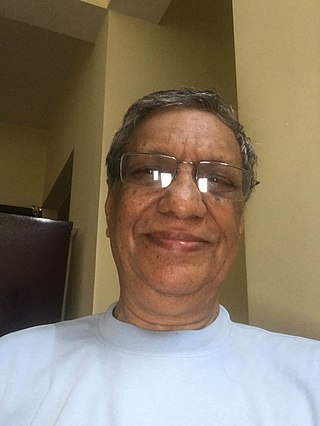
Prem Chand Pandey is an Indian space scientist, planetary scientist, and academic in the fields of satellite oceanography, remote sensing, atmospheric science, the Antarctic and climate change, and also he is the founding director of the National Centre for Polar and Ocean Research (NCPOR).

The Somali Current is a warm ocean boundary current that runs along the coast of Somalia and Oman in the Western Indian Ocean and is analogous to the Gulf Stream in the Atlantic Ocean. This current is heavily influenced by the monsoons and is the only major upwelling system that occurs on a western boundary of an ocean. The water that is upwelled by the current merges with another upwelling system, creating one of the most productive ecosystems in the ocean.

The GEOMAR - Helmholtz Centre for Ocean Research Kiel (GEOMAR), formerly known as the Leibniz Institute of Marine Sciences, is a research institute in Kiel, Germany. It was formed in 2004 by merging the Institute for Marine Science with the Research Center for Marine Geosciences (GEOMAR) and is co-funded by both federal and provincial governments. It was a member of the Leibniz Association until 2012 and is coordinator of the FishBase Consortium. Since 2012 it is member of the Helmholtz Association and named GEOMAR - Helmholtz Centre for Ocean Research Kiel. The institute operates worldwide in all ocean basins, specialising in climate dynamics, marine ecology and biogeochemistry, and ocean floor dynamics and circulation. GEOMAR offers degree courses in affiliation with the University of Kiel, and operates the Kiel Aquarium and the Lithothek, a repository for split sediment core samples.

LOHAFEX was an ocean iron fertilization experiment jointly planned by the Council of Scientific and Industrial Research (CSIR) in India and the Helmholtz Association in Germany. The purpose of the experiment was to see if the iron would cause an algal bloom and trap carbon dioxide from the atmosphere. While an algal bloom did result, it was smaller than expected and as most of the algae were consumed by zooplankton instead of sinking to the ocean floor, the amount of carbon dioxide permanently removed from the atmosphere was deemed negligible. The result was thus a setback for plans to use iron fertilization of the oceans to create negative carbon dioxide emissions.
Syed Wajih Ahmad Naqvi is an Indian marine scientist and the former director of the National Institute of Oceanography. His work has concentrated in oceanic water chemistry, biogeochemistry, and chemical interrelations with living organisms. He has also performed research on freshwater ecosystems. He was the chief Indian scientist of LOHAFEX, an ocean iron fertilization experiment jointly planned by the Council of Scientific Industrial Research (CSIR), India, and Helmholtz Foundation, Germany.
Aditi Pant, is an Indian oceanographer. She was the first Indian woman to visit Antarctica, alongside geologist Sudipta Sengupta in 1983 as part of the Indian Antarctic Program. She has held prominent positions at institutions including the National Institute of Oceanography, National Chemical Laboratory, University of Pune, and Maharashtra Academy of Sciences.
The International Indian Ocean Expedition (IIOE) was a large-scale multinational hydrographic survey of the Indian Ocean which took place from September 1, 1959, to December 31, 1965, Jawaharlal Nehru then PM of India inaugurated International Indian Ocean Expedition (IIOE) in 1959 with collaboration with foreign universities. It worked to describe and understand the basic features of the Indian Ocean.

Nedumangattu Kesava Panikkar (1913–1977) was an Indian zoologist, a former director of the Central Marine Fisheries Research Institute, a former adviser to the Government of India on fishery development and a former vice chancellor of the Cochin University of Science and Technology. He was a recipient of the Indian civilian award of Padma Shri in 1973.
Hassan Nasiem Siddique (1934–1986) was an Indian marine geologist and the director of the National Institute of Oceanography. He was the deputy leader of the first Indian expedition to the Antarctica during 1981–82. He was known for his geological studies on Bay of Bengal and the Arabian Sea and was an elected fellow of the Indian National Science Academy, Geological Society of India, Association of Exploration Geophysicists and the National Academy of Sciences, India. The Council of Scientific and Industrial Research, the apex agency of the Government of India for scientific research, awarded him the Shanti Swarup Bhatnagar Prize for Science and Technology, one of the highest Indian science awards for his contributions to Earth, Atmosphere, Ocean and Planetary Sciences in 1978. The Government of India awarded him the fourth highest Indian civilian honour of Padma Shri in 1983.
Satish Ramnath Shetye is an Indian geophysicist, oceanographer and a former vice chancellor of the University of Goa. He is a former director of the National Institute of Oceanography (NIO) and is known for his researches on the monsoon-driven currents along the Indian coast. He is an elected fellow of all the three major Indian science academies viz. Indian National Science Academy, Indian Academy of Sciences, National Academy of Sciences, India as well as the Indian Geophysical Union. The Council of Scientific and Industrial Research, the apex agency of the Government of India for scientific research, awarded him the Shanti Swarup Bhatnagar Prize for Science and Technology, one of the highest Indian science awards for his contributions to Earth, Atmosphere, Ocean and Planetary Sciences in 1992.

Rengaswamy Ramesh (1956–2018) was an Indian climatologist, oceanographer, a former Prof. Satish Dhawan Professor at the Physical Research Laboratory and a senior professor at the National Institute of Science Education and Research, Bhubaneswar. He was known for paleo-climatic and paleo-oceanographic studies and was an elected fellow of all the three major Indian science academies viz. Indian National Science Academy, Indian Academy of Sciences, and the National Academy of Sciences, India as well as of The World Academy of Sciences. The Council of Scientific and Industrial Research, the apex agency of the Government of India for scientific research, awarded him the Shanti Swarup Bhatnagar Prize for Science and Technology, one of the highest Indian science awards for his contributions to Earth, Atmosphere, Ocean and Planetary Sciences in 1998.
Kolluru Sree Krishna is an Indian marine geophysicist and the chief scientist at the National Institute of Oceanography, India. He is known for his studies on the evolution of the Indian Ocean and is an elected fellow of all the three major Indian science academies: Indian National Science Academy, Indian Academy of Sciences, and the National Academy of Sciences, India. The Council of Scientific and Industrial Research, the apex agency of the Government of India for scientific research, awarded him the Shanti Swarup Bhatnagar Prize for Science and Technology, one of the highest Indian science awards for his contributions to Earth, Atmosphere, Ocean and Planetary Sciences in 2001.
Parthasarathi Chakraborty is an Indian environmental geochemist, a former senior scientist at the CSIR-National Institute of Oceanography and an associate professor at the Indian Institute of Technology Kharagpur, India. Chakraborty is known for his studies in the field of Environmental Chemistry. He made contributions to the field of Environmental Geochemistry which has facilitated our understanding of the metals-natural ligands interactions in natural and marine environments. He is a recipient of the National Geoscience Award-2015 and an elected fellow of the Indian Geophysical Union.The Council of Scientific and Industrial Research, the apex agency of the Government of India for scientific research, awarded him the Shanti Swarup Bhatnagar Prize for Science and Technology, one of the highest Indian science awards, for his contributions to Earth, Atmosphere, Ocean and Planetary Sciences in 2018.
Deep Ocean mission is an Indian initiative to undertake the deep ocean exploration focused on India's exclusive economic zones and continental shelf. The program will consist of various crewed and uncrewed submersibles exploring the sea bed. One of the primary aims of the mission is to explore and extract polymetallic nodules, which are composed of minerals like manganese, nickel, cobalt, copper and iron hydroxide. The metals can used in the manufacturing of electronic devices, smartphones, batteries and solar panels.
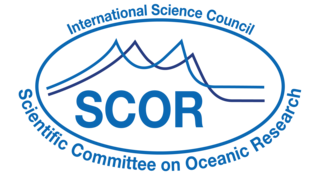
The Scientific Committee on Oceanic Research (SCOR) is an interdisciplinary body of the International Science Council. SCOR was established in 1957, coincident with the International Geophysical Year of 1957-1958. It sought to bring scientists together to answer key ocean science questions and improve opportunities for marginalised scientists.

